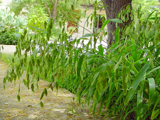Native Plants

Q. Who is Mr. Smarty Plants?
A: There are those who suspect Wildflower Center volunteers are the culpable and capable culprits. Yet, others think staff members play some, albeit small, role. You can torture us with your plant questions, but we will never reveal the Green Guru's secret identity.
Did you know you can access the Native Plant Information Network with your web-enabled smartphone?
Ask Mr. Smarty Plants is a free service provided by the staff and volunteers at the Lady Bird Johnson Wildflower Center.

rate this answer
Thursday - April 01, 2010
From: Austin, TX
Region: Southwest
Topic: Non-Natives
Title: Non-native, invasive bamboo for sloped river bank in Texas?
Answered by: Barbara Medford and Nan Hampton
QUESTION:
What type of native plants/trees/shrubs/grasses would you recommend planting on a 20 ft sloped bank on the Colorado river in Texas to prevent further erosion of the bank? How do you feel about bamboo? I hear it is excellent at preventing erosion but can be invasive.ANSWER:
We feel really, really bad about bamboo. It is not only invasive but non-native to North America. At the Lady Bird Johnson Wildflower Center we deal only in plants that are native not only to North America but to the area in which they are being grown. See this eHow website on How to Get Rid of Bamboo to demonstrate why you do NOT want to plant that.
Grasses are what you need. Their extensive fibrous root systems hold the soil in place. Here are a few that should do the job:
Chasmanthium latifolium (Inland sea oats) does well in part shade and shade and on stream banks.
Andropogon glomeratus (bushy bluestem) requires full sun (6 hours or more per day) and moisture.
Tripsacum dactyloides (eastern gamagrass) grows in part shade (2 to 6 hours sun per day) and does well on stream banks.
Andropogon gerardii (big bluestem) grows in sun and part shade and can withstand flooding.
Muhlenbergia lindheimeri (Lindheimer's muhly) requires sun and often found by streams.
Panicum virgatum (switchgrass) for sun and part shade and grows well in damp places.
The following shrubs, along with the grasses, should also do well to help control erosion.
Cephalanthus occidentalis (common buttonbush) grows in part shade and shade.
Forestiera pubescens (stretchberry) grows in sun, part shade and shade.
Sabal minor (dwarf palmetto) grows in sun, part shade and shade.
Lindera benzoin (northern spicebush) grows in sun, part shade and shade.
Malvaviscus arboreus var. drummondii (wax mallow) grows in part shade and shade.
Prunus rivularis (creek plum) grows in part shade and is good for erosion control.
Here are photos from our Image Gallery:
More Non-Natives Questions
Care of Rio Grande Wild Petunia
July 17, 2007 - I have bought the Rio Grande Wild Petunia, Ruellia davisiorum. How should I look after it?
view the full question and answer
Problems with non-native hollyhock in Austin
April 03, 2010 - Our hollyhocks develop small yellow spots on the leaves; these eventually spread into little swellings on the underside; I think of them as lesions. They spread and the leaf turns brown and shrivels ...
view the full question and answer
Non-native dwarf palm leaves yellowing in Katy TX
March 30, 2013 - 1 month ago we planted dwarf palms, the leaves are turning yellow, does this mean we are over watering them? If so how much water do they require? Is there anything we can give them? We also have a fa...
view the full question and answer
Recovery of non-native star jasmine from freezing in New York
April 22, 2007 - Hello, I have a star jasmine plant that was left outside over the winter. Will it come back to life? Thank you.
view the full question and answer
White powder on non-native houseplants from Fort Davis TX
February 11, 2011 - I have a white powder on my houseplants that I can't figure out what it is or what to do about it? (Dracaena & Corn plants) Could be a fungus can you help? (can send a photo if you will tell me how t...
view the full question and answer
| Support the Wildflower Center by Donating Online or Becoming a Member today. |

